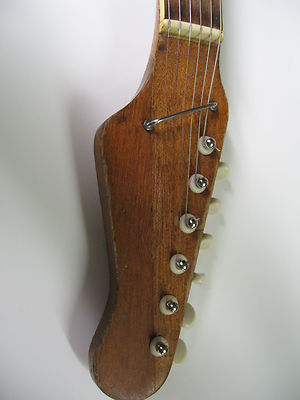

And he’s like, ‘No, it’s a piece of shit!’ and the owner is like, ‘Nah, $500.’ “And so he goes up to the desk, asks this really New York owner how much he wants for it – $500. And they find the guitar in the attic of this guitar shop on like 32nd Street or something, and then John says to Rory: ‘Look man, they’ll try to pull something here because you’re foreign… I’ll take the guitar over – how much do you want to pay for it?’ And Rory says: ‘I don’t know, $50?’ ‘Right, we’ll get it for $50’.

“So he met up with him, and John tells this lovely story about how they met for the first time and then went guitar shopping in New York in 1969. And he asked Clapton if he knew anywhere in New York where he could one of these guitars, and Clapton tells him to speak to this guy, John Hammond Jr, the blues player. “I remember hearing the story of how he was on the Blind Faith tour in New York, and he wanted a particular guitar, an old Kay I think, because he’d seen Lonnie Johnson playing one on an album cover. And so he would say: ‘Well I’ve got to get that, because that makes a great blues sound,’ rather than a luxury Les Paul or whatever. “And they would play cheaper guitars, because that’s what they could afford. “Rory loved collecting blues memorabilia – vinyl, posters, photographs – and he was fascinated by what the old blues guys would play,” Daniel explains. So much of Rory’s collection is taken up with these unusual guitars that weren’t exactly trendy at the time, and a lot of it comes back to his deep love of blues and blues history. “He’d be looking at the Nationals, the Teiscos, the Silvertones, asking ‘What’s that? What does it sound like? Can I break the tremolo arm off it?’” “If he was here now, he’d be ignoring all that,” he continues, gesturing to the wall of old Gibsons and Fenders in New King’s Road Vintage Guitar Emporium. He wouldn’t be interested in buying that year’s new Strat or whatever. “When he was on the road, especially in America, he would just go into pawn shops and buy loads of Kays, Harmonys, Tokais and Teiscos. “I feel like this is another one of those guitars where he saw it and thought, ‘That’s mad, nobody else is playing one, I’ll take it!’ And it probably only cost him a couple of hundred dollars, if that! “This is such a mad thing! It’s so cool – it’s got a handle, nobody needs a handle!” Daniel Gallagher – Rory’s nephew – laughs. The Japanese budget brand might have been recently reborn as a maker of oddball effects, but during the mid 1960s, it was bringing its eccentric design approach to guitars such as this offset. International Shipping Rates listed are ESTIMATES ONLY! Please contact us for precise shipping outside of the U.S.Our final leftfield electric comes from Teisco. PLEASE NOTE: All sales are final, as we have a No Return Policy.
#How to identify 60 teisco guitar full#
We are happy to offer full descriptions of condition and sound of all of our instruments to the best of our expertise. Every call, email and inquiry will be answered. In our 30+ years of business, Customer Service has always been of the utmost importance to us. Nut width is 1.68" and a 9.5" radius. Teisco is making a comeback and you cannot go wrong with this one. This is one of our most looked-at pieces at guitar shows. Weighs 6lbs 3oz. The playability is spot on and the guitar has a tone like no other. Most weren't treated tenderly and often taken apart for parts a lot were just tossed. But it's very important to remember these were catalog guitars. There are some dings and scratches and some chips. The guitar has the typical playwear of a 60's Teisco.

We meticulously serviced and cleaned this piece up, as it has become one of our most intriguing finds. So while this guitar's body is an Idol, the neck is a Teisco while the pickups were current stock. This guitar is comprised of the leftover parts of the three different factories trying to use up remaining stock before going out of business. For the next couple of months, the company was producing guitars under the Firstman, Idol and Honey names. In 1966, Kawaii bought the Teisco company and Teisco Gen Gakki ceased production. From there, the guitars were shipped to the Teisco Tokyo factory to have the electronics attached. In the early 60's during the Japanese guitar boom, Teisco Gen Gakki was making guitars for Teisco. This piece is very close to a Honey SG-5 but with different pickups. Thanks to our new friend Frank Meyers at Drowning in Guitars, we were finally able to identify this ol' gal.


 0 kommentar(er)
0 kommentar(er)
